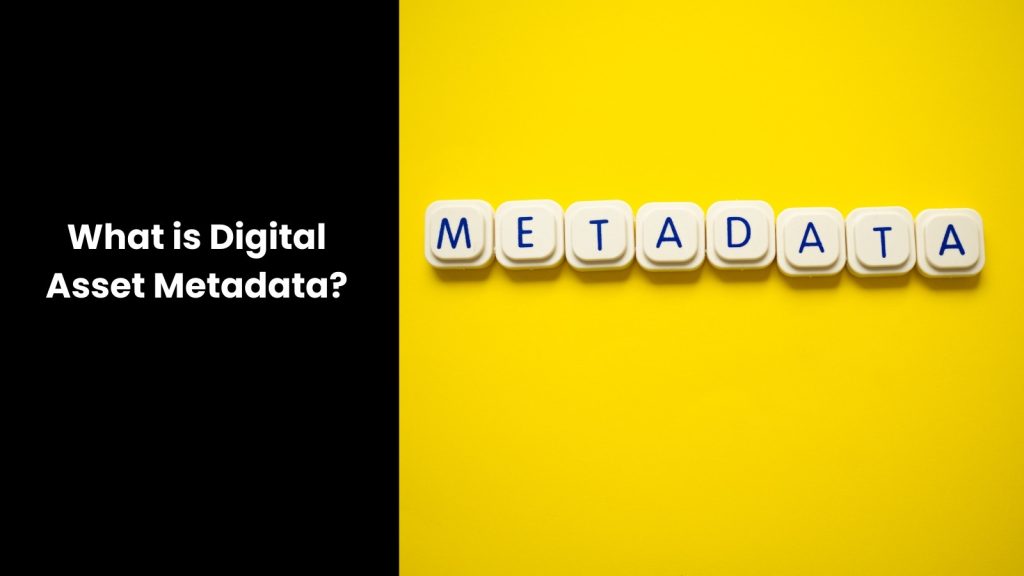In this article, we will explore how metadata transforms asset management, supports long-term preservation, and aids in strategic decision-making at the end.
What is Digital Asset Metadata?

- In the purest sense of the word, this is simply information about other information.
- This means it acts as a label or description that provides crucial details about a digital asset, such as an image, video, or document. For example, imagine you have a toolbox filled with various tools like drills, saws, and sanders. If these tools are scattered and you do not have any labels on them, finding the right tool when you need it can be extremely frustrating. Will you agree?
- If simply put, metadata works the same way for digital assets. It tags each file with specific information such as titles, descriptions, keywords, and dates, making it much easier to manage and locate these assets.
- For example, if you have several photos of different events, metadata can include details like the event name, date, location, and even who is in the photo. This additional information helps you quickly search and find the exact photo you need without having to sift through all your files manually.
- When asset managers attach this context to each digital file, metadata turns a chaotic collection into an organised, easily navigable library. This organisation improves efficiency, helps in managing files more effectively, and ensures that asset managers can retrieve assets swiftly when required.
- If there is no metadata in use, digital asset management would give headaches to asset managers, and it would be time-consuming, much like trying to work with an unlabelled toolbox.
Importance of Metadata in Digital Asset Management

Preservation and Longevity
You already know that they provide detailed information about each asset’s creation, changes, and technical details. When you attach metadata to digital files, you record important data such as the original creation date, who made the file, any changes made over time, and the technical specifications of the file. This information is vital for maintaining the asset’s value and usability in the long run.
This historical context helps ensure that digital assets remain accessible and useful, even as technology evolves. Proper metadata also helps prevent data loss as it documents how an asset has been modified, which is crucial for recovering the file if something goes wrong. In a way, it acts like a detailed record that keeps track of all the changes and technical aspects of the file, making it easier to manage and use the asset in the future.
Plus, it ensures that future users can understand and work with the assets effectively, regardless of technological advancements or changes in software. Without this detailed information, digital assets might become obsolete or difficult to access over time.
Consistency in Usage
It achieves this by providing essential information about each asset, such as its origin, usage rights, and version history. Another fact is that it ensures that everyone in the company uses the correct and most up-to-date version of the digital asset, maintaining brand consistency.
Metadata also includes information about how and where the asset can be used, such as licensing details or restrictions. This prevents misuse or incorrect application of the asset by making clear what is allowed and what is not. Furthermore, metadata tracks the asset’s version history, so if updates or changes are made, everyone involved can access the right version and understand what has been altered.
This helps in avoiding confusion and ensures that the asset’s integrity is preserved across different uses and projects. With these details readily available, metadata helps in maintaining uniformity and avoiding mistakes, making sure that assets are used correctly and consistently.
Enhanced Asset Discovery
Imagine you have a broad spectrum of machinery, but you only remember a few details about each one. Without metadata, finding a specific machine in the virtual space could be a difficult task, especially if you do not know exactly what it is called or where it is stored.
However, when you use metadata in a system, you can tag each asset’s digital replica with useful details like the event it was taken at, the date, the people in the photo, and any relevant keywords. This descriptive metadata helps users search for and identify the asset they need based on various criteria, even if they do not know the exact name or location of the file.
For example, if someone is looking for their assets from the warehouse, they can search by keywords like ‘AGV robots’ or ‘packaging machine’ instead of having to remember the specific file name. The metadata helps the search engine narrow down results quickly, making it easier for users to find the right asset.
Improved Searchability
This detailed information allows the software to create a rich database where users can quickly search for specific assets using various criteria. For example, if a technician needs to find all machines that require maintenance or have specific features, they can use keywords or filters based on the metadata to locate these assets swiftly.
Without metadata configuration abilities, searching for a particular asset would involve manually sifting through numerous files or records, which is time-consuming and inefficient. Metadata transforms this process as it allows users to enter search terms or select filters that narrow down results based on the detailed information attached to each asset.
This capability not only saves time but also reduces errors and improves overall efficiency in managing assets. As a result, the manufacturing industry can keep track of critical equipment more effectively, respond to maintenance needs promptly, and ensure smooth operations without unnecessary delays.
Cerexio Solutions for Perfect Digital Asset Management

In order to achieve perfect digital asset management, it is better to consider using Cerexio Solutions, which excels in metadata configuration. Cerexio’s platform offers robust metadata tagging, allowing precise categorisation and detailed descriptions of digital assets. This feature ensures efficient searching, easy retrieval, and consistent usage across projects.
Gaining Powerful Insights via Metadata in Digital Asset Management

According to what we discussed throughout this article, utilising metadata in digital asset management empowers organisations to gain deep insights into their digital assets. This enhanced visibility facilitates efficient asset retrieval, accurate usage tracking, and better decision-making. If they can integrate strong metadata practices, companies can improve their asset management strategies to another level.

